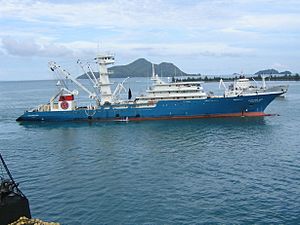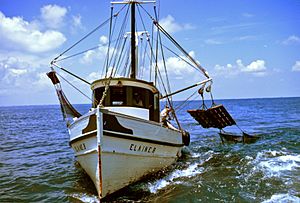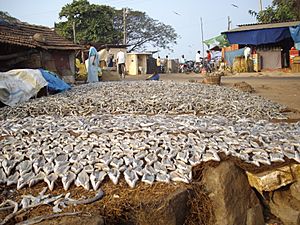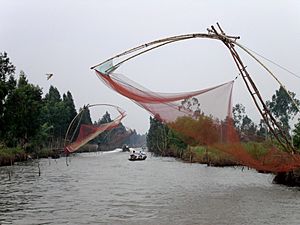Fishing industry facts for kids
All activities that are concerned with growing, catching, processing or transporting fish either as a hobby or as an economic activity is called Fishing industry.
According to the FAO definition it includes recreational, subsistence and commercial fishing, and the harvesting, processing, and marketing sectors. The commercial activity is aimed at the delivery of fish and other seafood products for human consumption or as input factors in other industrial processes. Directly or indirectly, the livelihood of over 500 million people in developing countries depends on fisheries and aquaculture.
Contents
Sectors
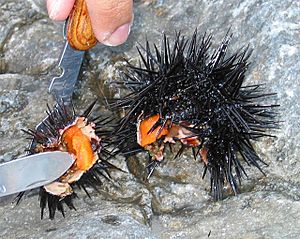
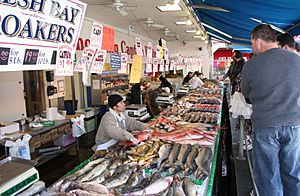
There are three principal industry sectors:
- The commercial sector: comprises enterprises and individuals associated with wild-catch or aquaculture resources and the various transformations of those resources into products for sale. It is also referred to as the "seafood industry", although non-food items such as pearls are included among its products.
- The traditional sector: comprises enterprises and individuals associated with fisheries resources from which aboriginal people derive products in accordance with their traditions.
- The recreational sector: comprises enterprises and individuals associated for the purpose of recreation, sport or sustenance with fisheries resources from which products are derived that are not for sale.
Commercial fishing
The top producing countries were, in order, the People's Republic of China (excluding Hong Kong and Taiwan), Peru, Japan, the United States, Chile, Indonesia, Russia, India, Thailand, Norway and Iceland. Those countries accounted for more than half of the world's production; China alone accounted for a third of the world's production.
Fish farming
Aquaculture is the cultivation of aquatic organisms. Unlike fishing, aquaculture, also known as aquafarming, is the cultivation of aquatic populations under controlled conditions. Mariculture refers to aquaculture practiced in marine environments. Particular kinds of aquaculture include algaculture (the production of kelp/seaweed and other algae); fish farming; shrimp farming, shellfish farming, and the growing of cultured pearls.
Fish farming involves raising fish commercially in tanks or enclosed pools, usually for food. Fish species raised by fish farms include carp, salmon, tilapia, catfish and cod. Increasing demands on wild fisheries by commercial fishing operations have caused widespread overfishing. Fish farming offers an alternative solution to the increasing market demand for fish and fish protein.
Fish processing
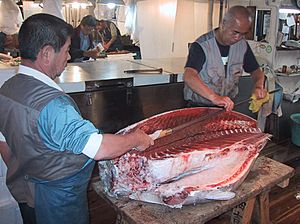
Fish processing is the processing of fish delivered by commercial fisheries and fish farms. The larger fish processing companies have their own fishing fleets and independent fisheries. The products of the industry are usually sold wholesale to grocery chains or to intermediaries.
Fish processing can be subdivided into two categories: fish handling (the initial processing of raw fish) and fish products manufacturing. Aspects of fish processing occur on fishing vessels, fish processing vessels, and at fish processing plants.
Another natural subdivision is into primary processing involved in the filleting and freezing of fresh fish for onward distribution to fresh fish retail and catering outlets, and the secondary processing that produces chilled, frozen and canned products for the retail and catering trades.
Fish products
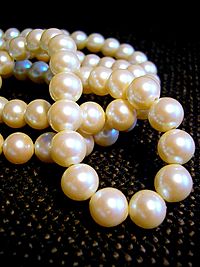
Fisheries are estimated to currently provide 16% of the world population's protein. The flesh of many fish are primarily valued as a source of food; there are many edible species of fish. Other marine life taken as food includes shellfish, crustaceans, sea cucumber, jellyfish and roe.
Fish and other marine life can also be used for many other uses: pearls and mother-of-pearl, sharkskin and rayskin. Sea horses, star fish, sea urchins and sea cucumber are used in traditional Chinese medicine. Tyrian purple is a pigment made from marine snails, sepia is a pigment made from the inky secretions of cuttlefish. Fish glue has long been valued for its use in all manner of products. Isinglass is used for the clarification of wine and beer. Fish emulsion is a fertilizer emulsion that is produced from the fluid remains of fish processed for fish oil and fish meal.
In the industry the term seafood products is often used instead of fish products.
Traditional sector
The traditional fishing industry, or artisan fishing, are terms used to describe small scale commercial or subsistence fishing practises, particularly using traditional techniques such as rod and tackle, arrows and harpoons, throw nets and drag nets, etc. It does not usually cover the concept of fishing for sport, and might be used when talking about the pressures between large scale modern commercial fishing practises and traditional methods, or when aid programs are targeted specifically at fishing at or near subsistence levels.
Recreational sector
The recreational fishing industry consists of enterprises such as the manufacture and retailing of fishing tackle and apparel, the payment of license fees to regulatory authorities, fishing books and magazines, the design and building of recreational fishing boats, and the provision of accommodation, fishing boats for charter, and guided fishing adventures.
See also
 In Spanish: Industria pesquera para niños
In Spanish: Industria pesquera para niños


